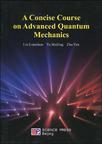高等量子力学简明教程
出版时间:1970-1 出版社:科学出版社 作者:Liu Lianshou,Yu Meiling,Zhu Yan 著 页数:259
Tag标签:无
前言
I have been teaching the course Advanced Quantum Mechanics to graduate studentsat Huazhong Normal University since 1984. Using various textbooks published insideand/or outside China as references, I was able to assemble together a few topics, suchas coherent state, WKB approximation, wave-packet scattering. Lippmann-Schwingerequation, etc for the graduate course that were not already covered by the undergrad-uate Quantum Mechanics course. The idea of writing a new book first emerged in2003 under the encouragement of my students, especially Ms. Xiaoyan Lin. A firstversion of this book appeared in 2004 and was printed for the graduate course touse. From then on the book was revised and printed every year for the course. Afterseveral teaching-revision cycles, it is now ready for publication.Advanced quantum mechanics is a basic course for the graduate students whoplan to specialize in various fields of physics, e.g. theoretical physics, high energyphysics, nuclear physics, condensed matter physics, atomic and molecular physics,optics, astrophysics, etc. Taking this diversity of specialities into account, in addi-tion to constructing a strict scientific framework for quantum mechanics, the presentmanuscript covers a comparatively wide range of topics.Starting from the experimentally observed wave-particle duality of microscopicsystem, the Hilbert space is introduced naturally. With the exception of the basicprinciples of quantum mechanics, no other assumption or "principle" is representeddirectly and simply by writing. In particular, the physical quantities, such as momen-tum, angular momentum, are not given through writing out manually their operatorsin some special representation, e.g. coordinate representation, but are defined throughtheir commutators, starting from their fundamental property of being generators ofcontinuous space transformation. The "uncertainty principle", "Pauli incompatibilityprinciple" are no longer principles, but are derivable theorems in quantum mechanics.There are already quite a number of textbooks for advanced quantum mechanicsavailable. What is the peculiarity of this book that makes it worthy of publication?We have the following considerations.
内容概要
This book covers the main topics of modern advanced quantum mechanics in a concise way. It meets the requirement of the graduate students who plan to specialize in various fields of physics, e.g. theoretical physics, high energy physics, nuclear physics, condensed matter physics, atomic and molecular physics, optics, astrophysics and etc. It is for use in a one-semester graduate course. The main concepts, theorems and applications of quantum mechanics are written in the text, while most of the derivations are put in the exercises. Hints are given for selected exercises.
书籍目录
PrefaceChapter 1 Quantum states and physical quantities 1.1 Quantum states as linear vectors in Hilbert space 1.1.1 Quantum states as linear vectors 1.1.2 Axiom of quantum mechanics concerning quantum states 1.2 Physical quantities as operators in Hilbert space 1.2.1 Eigenvalue and eigenvector of Hermitian operator 1.2.2 Orthogonal-normalization condition of eigenvectors 1.2.3 Axiom of quantum mechanics concerning physical quantities 1.2.4 Completeness condition of eigenvector system 1.2.5 Projection operator 1.2.6 Density operator Pure state and mixed state 1.3 Representation 1.3.1 Definition of representation 1.3.2 Representation transformation 1.3.3 Enter in and escape from a representation 1.3.4 Invariances of representation transformation 1.4 Operators as non-commuting quantities 1.4.1 Simultaneous measurability of physical quantities 1.4.2 Commutator algebra 1.4.3 Function of operator 1.5 Unitary transformation Generator of continuous transformation 1.5.1 Similar transformation and unitary transformation 1.5.2 Relation between unitary operator and Hermitian operator 1.5.3 Continuous transformation Generator 1.5.4 Space displacement Momentum 1.5.5 Space rotation Angular momentumChapter 2 Time evolution of microscopic system SchrSdinger equation and propagator 2.1 Time evolution in coordinate representation 2.2 Time evolution operator in Hilbert space 2.3 Picture in quantum mechanics 2.3.1 Definition of picture and picture-transform in quantum mechanics 2.3.2 SchrSdinger picture and Heisenberg picture 2.3.3 Interaction picture 2.4 Time evolution in the form of path integral 2.4.1 Functional integral formula for propagator 2.4.2 Functional integral as limit of multiple-integral 2.4.3 Functional integral as sum over path 2.4.4 Path-integral of Gaussian type 2.4.5 From path integral to SchrSdinger equation 2.5 Diffraction phenomena in quantum mechanics 2.5.1 The role of phase in quantum mechanics 2.5.2 Double-slot diffraction 2.5.3 Aharonov-Bohm effect Magnetic-flux quantum 2.6 Symmetry of microscopic system and conservation of physical quantity 2.6.1 Symmetry of microscopic system 2.6.2 Conservation of physical quantity 2.6.3 Parity 2.6.4 Time reversalChapter 3 Angular momentum 3.1 General solution of the eigenvalue problem of angular momentum 3.1.1 The procedure for solving eigenvalue problem directly in Hilbert space 3.1.2 Solution of the eigenvalue problem of angular momentum 3.2 Two kinds of angular momentum 3.2.1 Orbital angular momentum 3.2.2 Spin 3.3 Spin 1/2 3.3.1 Properties of Pauli matrix 3.3.2 Density matrix of spin 1/2 state Polarization vector 3.4 Representation of angular momentum 3.4.1 Reducible and irreducible representations 3.4.2 Irreducible tensor operator 3.4.3 Property of D function 3.5 Addition of angular momentum Clebsch-Gordan coefficients 3.5.1 Addition of angular momentum 3.5,2 Clebsch-Gordan coefficients 3.5.3 Addition of D functionChapter 4 Multi-particle system 4.1 Axiom on indistinguishability of identical particles 4.2 Fock representation of multi-particle state -- Discrete spectrum 4.2.1 The representation basis 4.2.2 Basic operators 4.2.3 Action of basic operators on representation basis 4.2.4 Representation- and canonical-transformations of annihilation and creation operators 4.2.5 Operators of physical quantities in multi-particle system ……Chapter 5 Uncertainty relation Coherent stateChapter 6 One-dimensional problem Chapter 7 Three-dimensional ScatteringChapter 8 Relativistic quantum mechanicsHnts to Selected Exercises
章节摘录
插图:
编辑推荐
《高等量子力学简明教程(英文版)》由科学出版社出版。
图书封面
图书标签Tags
无
评论、评分、阅读与下载
用户评论 (总计4条)
- 卖家发货很快,快递态度很好!
- 挺好的,但是角动量理论相对较少!
- 中国人写的充外文,又不是华侨不懂汉语。
- 我碰到的第一本英文专业书 特此一顶
